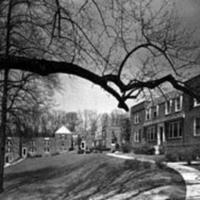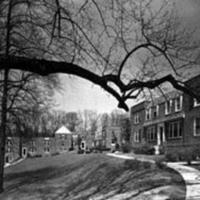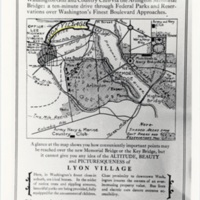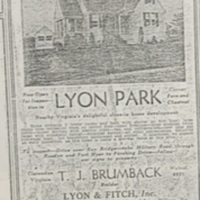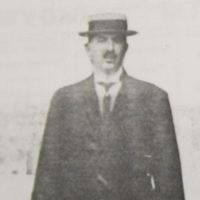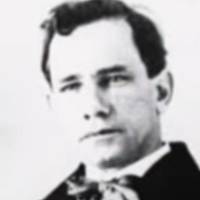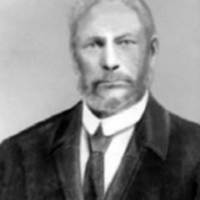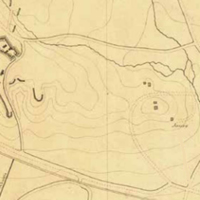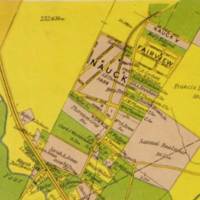Browse Items (41 items total)
Gustave Ring was a successful developer and builder. In 1935 he began construction of the Colonial Village garden apartment housing complex in Arlington, Virginia (pictured above) with FHA funding. Ring was one of the first builders to work with the FHA. He helped to shape their lending policies and by 1939 he controlled $37 million of the $100 million worth of mortgage insurance provided by the federal institution. Ring's other projects included Arlington Village (1939), the Westchester Apartments (1930) and the Ring Building (1948) in Washington, and other construction around the country.
Collection: Neighborhoods
Colonial Village is a garden-style apartment complex created by professional developer Gustave Ring in 1935. It contains more than 200 Colonial Revival red brick buildings surrounded by landscaped paths and lawns.
The development was created to help house the huge number of recently arrived federal employees using funds from the Federal Housing Administration (FHA). The Colonial Village complex was one of the first developments to work with the FHA and Ring helped shape their policies.
The development was created to help house the huge number of recently arrived federal employees using funds from the Federal Housing Administration (FHA). The Colonial Village complex was one of the first developments to work with the FHA and Ring helped shape their policies.
Collection: Neighborhoods
Maywood was founded in 1903 by Arlington Attorney General and developer Crandal Mackey. The community was originally a street-car suburb constructed along the Great Falls and Old Dominion rail line. From its founding to the present many of the community's residents work for the federal government. In 1915 the community was made up of approximately 39 late-Victorian homes by 1915, and by 1965 that number had grown to more than 900 homes.
Collection: Neighborhoods
Lyon Village was founded by local politician, lawyer, and developer Frank Lyon in 1923. Created four years after the opening of his Lyon Park neighborhood, Lyon Village was meant to be an exclusively middle class environment. Lyon Village featured standardized, pre-platted lots, each with 50 foot frontages, with strict building restrictions for the look and size of houses. The community was also segregated for whites only, as these homes contained restrictive covenants that blocked minorities from purchasing within the neighborhood until the mid-twentieth century.
Collection: Neighborhoods
Lyon Park was founded by politician, lawyer, and developer Frank Lyon in 1919. The 300 acre community was the largest real estate development in Virginia upon its opening. Lyon Park featured modest homes and highlighted the area's connections to Washington via the county's growing network of streetcar lines. The community continued to grow throughout the twentieth century, as the above home advertisement from the 1940s highlights.
Collection: Neighborhoods
Crandal Mackey was a prominent county politician and developer. Mackey was born in Louisiana in 1865. He was drawn to Arlington in 1885 while working for the War Department and attending Georgetown Law School. In 1890 Mackey helped to establish the Good Citizen's League, a powerful local social and political group that sought to shape the county's suburban development and promote Democratic political candidates. In 1902 Mackey was elected Commonwealth's Attorney with their support. The following year he established the Maywood neighborhood in Arlington.
Collection: Neighborhoods
Frank Lyon was a prominent Arlington politician and developer. During the late 1910s and early 1920s Frank Lyon and his Lyon & Fitch Realty Company subdivided and sold 465 acres in Arlington – nearly three percent of all the land in the county. These acres were divided between his two communities: Lyon Park and Lyon Village. The Lyon properties helped to transform Arlington’s built environment through their focus on pre-planned suburban subdivisions. Lyon also shaped county affairs as a member of the Good Citizen's League social and political organization, and as owner of "The Monitor" newspaper.
Collection: Neighborhoods
William A. Rowe escaped enslavement and fled to Freedman's Village in Arlington, where he became a prominent community leader. Rowe was trained as a blacksmith in the Village and became a particularly successful African American politician. He served as Supervisor of Jefferson District from 1871 to 1879 and even served as Board chairman from 1872 to 1883. After the closure of Freedman's Village, Rowe relocated to Green Valley in 1879 with his wife and three children. Rowe quickly re-established his role as a local political leader in his new community, serving as the area's Supervisor.
Collection: Neighborhoods
In 1844 Sarah and Levi Jones purchased 14 acres of land in eastern Arlington along Four Mile Run to farm and build a home. Their property, labeled "Jones," can be seen at the center of the map above. Throughout the decades before and after the Civil War, the Jones family expanded their farm, sold land to fellow African Americans to help create the Green Valley neighborhood, and became community leaders.
Little is known about Sarah's life before 1844, but Levi was born free in Fairfax, Virginia. His parents, Davy and Evy, were enslaved on George Washington's Mount Vernon plantation.
Little is known about Sarah's life before 1844, but Levi was born free in Fairfax, Virginia. His parents, Davy and Evy, were enslaved on George Washington's Mount Vernon plantation.
Collection: Neighborhoods
In the 1880s John Nauck platted the Nauck subdivision within the African American Green Valley community. Nauck was a white land developer from Washington, D.C. who sold lots to African Americans. Community institutions, including the Nauck's Citizens' Association, were named after Nauck and his subdivision. In the 1970s the name of the Green Valley community became known as Nauck.
Collection: Neighborhoods
